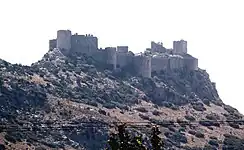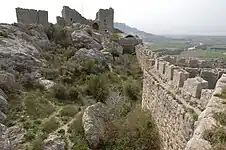| Yılankale | |
|---|---|
| Adana Province, Turkey | |
 Yılankale | |
 Yılankale Location of Yılankale within Turkey | |
| Coordinates | 37°00′52″N 35°44′52″E / 37.014444°N 35.747778°E |
| Site information | |
| Open to the public | Yes[1] |
| Condition | Ruins |
| Site history | |
| Built | 13th century |
| Built by | Leo (Levon) I[2][3] of the Armenian Kingdom of Cilicia |
Yılankale (lit. 'snake castle' in Turkish)[4][5][6] is a late 12th[7]–13th century[4] Armenian[3][8][9] castle in Adana Province of Turkey. It is known in Armenian as Levonkla[10] (Լևոնկլա[2] "Levon's fortress") after its possible founder—King Leo (Levon) I the Magnificent[2][3] (r. 1198/9–1219) of the Armenian Kingdom of Cilicia. Medieval Armenian names attached to the site are Kovara and Vaner.[11]
A hill castle, Yılankale is located on a rocky hill overlooking the east bank of the Ceyhan River,[6] and the Bronze and Iron Age site of Sirkeli Höyük, six kilometers west of the town of Ceyhan.[12] The building is locally known as the home of Shahmaran, a mythical creature half woman and half snake.[13][14]
Architecture
The walls, as well as the numerous horseshoe-shaped towers and vaulted chambers, are built with beautifully cut rusticated masonry and are carefully adapted to the coiling outcrop of limestone to create three baileys.[15] The archaeological and historical assessment of this castle published in 1987 (with a scaled plan) describes each unit in detail.[15] In the upper bailey is an Armenian chapel with its apse and north wall preserved.[3] The assumption that the relief of a seated king with two rampant lions in the gatehouse door depicts King Levon I (confirming the conclusion that he was the castle's early 13th-c. founder), was convincingly challenged by both iconographic and archaeological evidence, which shows that the relief portrays either Kings Het'um I (1226–70) or Het'um II (1289–1307).[16] The castle was abandoned during the reign of the Ramadanids in the mid-14th century.[17]
It has been described as the "most perfectly preserved Armenian castle" of the Çukurova (Cilicia) region.[3] The castle is open to the public[1] and was renovated in summer of 2014.[18]
History
In late 19th century, the inhabitants of Yılankale were Nogai immigrants from the Crimean War.[19]
Gallery
 An aerial view of the castle
An aerial view of the castle



See also
Comparable castles include:
References
- 1 2 The Rough Guide to Turkey. London: Rough Guides. 2003. p. 587.
Beyond here you'll see an Armenian castle on top of a mountain, 3 km to the south of the main road – the Yılan Kalesi, or "Snake Castle" (always open; &0.50).
- 1 2 3 Sarkissian, H. G. (1990). "Միքայել Վ. Հովհաննեսյան, Հայկական Կիլիկիո բերդերն ու բերդաքաղաքները [Mikael V. Hovhannisian, Fortress, city-fortress of Cilicia Armenia]". Lraber Hasarakakan Gitutyunneri (in Armenian). Yerevan: Armenian National Academy of Sciences (11): 92–93.
...Լևոն Մեծագործի Լևոնկլա դղյակը...
- 1 2 3 4 5 Edwards, Robert W. (1982). "Ecclesiastical Architecture in the Fortifications of Armenian Cilicia". Dumbarton Oaks Papers. Dumbarton Oaks, Trustees for Harvard University. 36: 170–171. doi:10.2307/1291466. JSTOR 1291466.
On the plain of Cilicia between the cities of Adana and Ceyhan stands the most perfectly preserved Armenian castle, Yilan. Because a relief on the gatehouse of the castle has been associated with King Levon I, the site may date from the period of his reign (1 198/99-1219). However, this identification is far from certain, since the relief is badly damaged.
- 1 2 Phillips, Jonathan (1995). "The Latin East, 1098–1291". In Riley-Smith, Jonathan (ed.). The Oxford Illustrated History of the Crusades. Oxford University Press. p. 136. ISBN 978-0-19-820435-0.
YILAN KALE (Castle of the Snakes). A huge thirteenth-century fortress standing high above the Pyramus river and overlooking the plain of Adana. The castle was a key stronghold for the Armenian rulers who controlled this region, and the remaining structure probably dates from the first half of the thirteenth century.
- ↑ Yale, Pat. "10 things to see in and around Adana". Today's Zaman. Archived from the original on 27 October 2014.
- 1 2 "Other historical regions". kultur.gov.tr. Republic of Turkey Ministry of Culture and Tourism. Archived from the original on 27 October 2014.
Yılan Kalesi (Snake Castle): It is located on a hill and champaign between Misis and Ceyhan. The castle, positioned on historical invasion and commerce road which connects Adana, Misis, Payas and Antalya through Gülek Straight, is the first chain of mountain castle chains.
- ↑ Pillement, Georges (1974). Unknown Turkey: Anatolia, Cappadocia, the eastern frontiers. Barbara Whelpton (translator). Johnson Publishing. p. 179.
...a medieval fortress, YILAN KALESI, probably built in the reign of Leon II, king of Little Armenia, towards the end of the 12th century near the right bank of the Ceyhan.
- ↑ Boase, T. S. R. (1978). The Cilician Kingdom of Armenia. Edinburgh: Scottish Academic Press. p. 185. ISBN 978-0-7073-0145-7.
- ↑ Permanent Delegation of Turkey to UNESCO (15 April 2014). "Ancient City of Korykos". whc.unesco.org. UNESCO World Heritage Centre.
Individual Armenian Castles found in the area of Adana, "Yilan Kale" and "Toprakkale, are the most outstanding ones.
- ↑ Adalian, Rouben Paul (2010). Historical Dictionary of Armenia. Lanham, Maryland: Scarecrow Press. p. 90. ISBN 978-0-8108-7450-3.
...Levonkla or Yilankale...
- ↑ Edwards, Robert W., "Settlements and Toponymy in Armenian Cilicia", Revue des Études Arméniennes 24, 1993, pp.219, 228-29.
- ↑ Youngs, G. R. (1965). "Three Cilician Castles". Anatolian Studies. British Institute at Ankara. 15: 125–134. doi:10.2307/3642505. JSTOR 3642505.
- ↑ Murray, J. (1837). "A General Statement of the Labours and Proceedings of the Expedition to Euphrates, Under the Command of Colonel Chesney". The Journal of the Royal Geographical Society of London. 7: 420 – via Google Books.
- ↑ "Snake Castle restored to welcome visitors". DailySabah. 2018-05-17. Retrieved 2019-08-20.
- 1 2 Edwards, Robert W. (1987). The Fortifications of Armenian Cilicia: Dumbarton Oaks Studies XXIII. Washington, D.C.: Dumbarton Oaks, Trustees for Harvard University. pp. 269–276, 286, pls.274a–286b, 303c. ISBN 0-88402-163-7.
- ↑ Edwards, Robert W (1984). "On the Supposed Date of Yılan Kalesi". Journal of the Society for Armenian Studies 1:23-33.
- ↑ "Yılankale (Kovara, Govara) "Snake Castle"". Çukurova University. Archived from the original on November 7, 2010.
- ↑ "Yilan Kale Gezi̇si̇". adanakultur.gov.tr (in Turkish). Adana Provincial Culture and Tourism Directorate. 7 June 2014.
- ↑ Barkley, Henry C. (1891). A Ride through Asia Minor and Armenia. London: William Clowes and Sons Limited. p. 193.
We pitched our tent in the village of Yilan Kalé (Snake Castle), belonging to some Nogai Tartars, who settled here just after the Crimean war.
External links
- A gallery of photographs of Yilan castle
- Carefully documented photographic survey, description and plan of Yılan Castle
- Drone footage of the castle from July 2022

